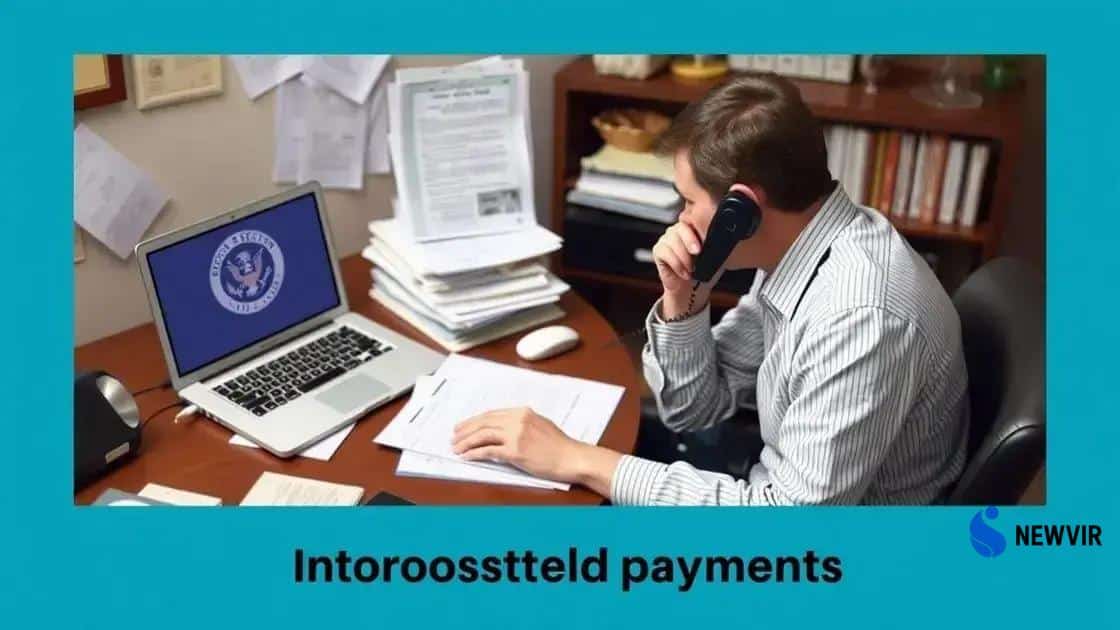Distribution of backdated Social Security payments: What you need to know

Backdated Social Security payments refer to funds owed for benefits that should have been paid in prior months due to processing delays, and claiming these requires specific documentation and eligibility confirmation.
Distribution of backdated Social Security payments can be a complex topic, but it’s crucial for many receiving benefits. Have you ever wondered how these payments work and what they mean for your finances? Let’s dive in.
Understanding backdated Social Security payments
Understanding backdated Social Security payments is essential for anyone involved in the benefits system. These payments can significantly impact your financial situation, so grasping their nuances is crucial.
What are Backdated Payments?
Backdated payments refer to money that should have been paid in previous months but has been delayed. Situations leading to such payments include waiting for approvals or processing delays. If you think you qualify, you might be entitled to a larger sum than you normally receive.
Why Do Backdated Payments Occur?
There are several reasons for backdated Social Security payments:
- Delayed application processing
- Changes in eligibility status
- Administrative errors
- System upgrades or updates
Administrative errors can be particularly frustrating. It’s important to keep track of your application status and ensure everything is in order. By knowing the causes, you can take steps to minimize issues.
How to Determine if You’re Eligible
To see if you’re eligible for backdated payments, review your Social Security statement. You should consider the date of your application and any changes in your circumstances. If your status changed, you might have more entitlement than expected.
Common eligibility factors include:
- Your age at the time of application
- Type of benefits applied for
- Any evidence of prior income
Understanding eligibility not only informs you about potential payments but also enables better financial planning. Awareness can also prevent unpleasant surprises.
Next Steps to Take
If you believe you are owed backdated payments, take action. Start by contacting your local Social Security office. They can provide guidance on your specific case.
Moreover, keeping good records can support your claims. Collecting all necessary documents will help simplify the process.
In essence, understanding backdated Social Security payments and what affects them can lead you to better financial outcomes. Whether you’re faced with delays or have questions about your eligibility, arming yourself with knowledge is the first step to ensuring you receive what you deserve.
Who qualifies for backdated payments?
When it comes to understanding who qualifies for backdated payments, it’s vital to look at specific criteria. Various factors determine your eligibility, and knowing them can help you secure the funds you deserve.
Eligibility Criteria
To qualify for backdated Social Security payments, you typically need to meet certain conditions. Consider the following:
- You must have applied for Social Security benefits.
- Your eligibility for benefits needs to be confirmed.
- Any changes to your status should be properly documented.
Understanding these criteria can streamline your process. If you have recently applied or if you faced delays, you might be eligible.
Common Scenarios for Eligibility
Several scenarios may result in qualifying for backdated payments. These include:
- Filing late due to various circumstances.
- Experiencing a sudden change in income or health.
- Errors in processing your initial application.
The factors above highlight scenarios that can affect your payments. For instance, if an individual applied but didn’t receive benefits promptly due to processing delays, they may be entitled to backdated funds.
It’s also important to keep track of dates. Knowing when you applied and when you began receiving benefits is crucial for claiming any owed payments. Each situation is unique, but being informed increases your chances of receiving support.
Checking Your Eligibility
The best way to check your eligibility is to contact your local Social Security office. They can review your case and provide personalized advice.
Additionally, keeping organized records helps immensely. Having documents ready can speed up the process if your case needs attention. Collect the necessary paperwork to avoid confusion.
In summary, understanding who qualifies for backdated payments is critical. It empowers you to take the right steps toward securing the financial support you may be entitled to.
Steps required to claim backdated payments

Claiming backdated payments may seem daunting, but knowing the steps can make the process easier. Following a structured approach will help ensure you receive the benefits you’re due.
Step 1: Gather Necessary Documents
Before making your claim, you need to collect important documents. This paperwork includes:
- Your Social Security number.
- Dates of application and any changes in eligibility.
- Proof of income if required.
- Any correspondence received from the Social Security Administration.
Having these items ready can expedite your claim process and prevent complications.
Step 2: Contact the Social Security Administration
Once you have your documents, the next step is to reach out to the Social Security Administration (SSA). You can do this by:
- Calling their toll-free number.
- Visiting your local SSA office.
- Using their official website to submit inquiries or forms.
Reaching out directly allows you to ask questions and clarify your concerns, ensuring you understand your next steps.
Step 3: Complete the Required Forms
After contacting the SSA, you will need to fill out specific forms to formalize your claim for backdated payments. Make sure to review each form thoroughly and provide accurate information.
Errors can delay your claim, so consider double-checking everything before submission. Be prepared for additional follow-up questions from the SSA.
Step 4: Follow Up Regularly
After submitting your claim, it’s essential to check in routinely. Call or visit the SSA to ensure your claim is being processed.
Staying proactive helps you avoid unnecessary delays. If more information is requested, provide it as soon as possible to keep your claim moving.
By following these steps carefully, you increase your chances of successfully claiming backdated payments. The process may take time, but being organized and informed makes all the difference.
Impact of backdated payments on financial planning
The impact of backdated payments on financial planning can be significant. Receiving these payments can help shape your budget and financial goals. Understanding how to leverage this money efficiently is vital.
Understanding Cash Flow
Backdated payments can improve your cash flow situation. If you receive a lump sum, it’s essential to know how to allocate these funds wisely. Consider setting aside money for savings or paying off debts. Managing your cash flow effectively allows you to secure a more stable financial future.
Budgeting Considerations
When planning your budget, include the potential for backdated payments. This means adjusting your budgets to reflect the influx of money. You could benefit by:
- Reassessing monthly expenses.
- Increasing your savings for emergencies.
- Investing in opportunities for growth.
Being proactive with your budgeting helps you make the most of these payments. Delaying decisions can lead to missed opportunities.
Debt Management
Another important aspect is your approach to debt. If you are managing loans or credit card balances, consider using part of your backdated payments to reduce these liabilities. A targeted approach can help you lower interest costs and free up more money for other expenses.
Balancing debt repayment with saving is key. Aim for a mix of paying off high-interest debts while also setting aside some funds for future needs.
Long-Term Financial Goals
Integrating backdated payments into your long-term financial goals is beneficial. Think about:
- Setting up a retirement account.
- Planning for large purchases, like a home or car.
- Building an emergency fund for unexpected expenses.
These payments can play a role in securing your financial future. It’s about making informed choices that align with your overall financial plan.
In summary, recognizing the impact of backdated payments on your financial planning can lead to healthier financial habits. By carefully considering your cash flow, budgeting, debt management, and long-term goals, you can maximize the benefits of these payments.
Common questions about backdated Social Security payments
When it comes to backdated Social Security payments, many questions arise. Understanding these common inquiries can help you navigate the process more effectively.
What Are Backdated Payments?
Backdated payments refer to the funds owed to you for benefits that should have been paid in previous months. These payments are made when there are delays in processing your application or changes in your eligibility. Knowing this helps you understand why you might be eligible for additional funds.
Who Is Eligible for Backdated Payments?
Eligibility often depends on various factors. To be eligible, you generally need to:
- Have applied for Social Security benefits.
- Have an approved application.
- Document any changes in your financial situation or eligibility.
These elements are crucial for determining your eligibility for those backdated funds.
How Do You Claim Backdated Payments?
To claim these payments, follow a structured approach. Start by gathering the necessary documents, such as:
- Your Social Security number.
- Details related to your application.
- Any communications from the Social Security Administration.
Once you have the documents, contact the Social Security Administration to initiate your claim.
How Long Does the Process Take?
The time needed to receive backdated payments can vary. Generally, once you file for your claim, it can take several weeks to process. Delays can occur due to high volumes of claims or needed additional information. Checking in with the SSA can keep you informed about the status of your payment.
What Should You Do If Your Claim Is Denied?
If your claim for backdated payments is denied, do not be discouraged. You have the right to appeal the decision. This process often involves:
- Reviewing the reasons for denial.
- Gathering additional evidence or documentation.
- Submitting a formal appeal within the specified time frame.
Being persistent can help you secure the funds you deserve.
In summary, having knowledge about these common questions regarding backdated Social Security payments empowers you to take informed steps in claiming what you are owed.
FAQ – Common Questions About Backdated Social Security Payments
What are backdated payments?
Backdated payments are funds owed to you for Social Security benefits that should have been paid in previous months due to delays in processing your application.
Who is eligible for backdated payments?
Eligibility typically requires you to have applied for benefits, have an approved application, and provided necessary documentation regarding any changes in your situation.
How do I claim backdated payments?
To claim backdated payments, gather your documents, contact the Social Security Administration, and fill out specific forms to initiate your claim.
What should I do if my claim is denied?
If your claim for backdated payments is denied, you can appeal the decision by reviewing the denial reasons, gathering additional evidence, and submitting a formal appeal within the time frame provided.






